Surprising fact: Spain draws over 80 million travelers some years, and many use fast trains that link Madrid to UNESCO cities in as little as 30 minutes.
I write from a place of repeat visits and practical planning. I love mixing big-city highlights with quieter corners that make a trip feel personal.
From Gaudí’s colorful world in Barcelona to royal palaces in Madrid, I show how coast, culture, and cuisine fit into efficient routes. Fast trains make time visit planning simple, so you can base yourself in one city and reach nearby treasures without wasting a day.
I point out which city works best for day trips, where to linger, and how to stitch regional loops so you cover more ground with less backtracking. Expect clear tips on timing, tickets, and the small moments that keep me returning.
Key Takeaways
- Spain combines major city landmarks with quieter neighborhoods that reward repeat trips.
- Fast trains link Madrid and nearby UNESCO cities in 30–90 minutes, perfect for day trips.
- Balance coast, culture, and cuisine to match your travel style.
- Choose a base city to maximize time and reduce backtracking.
- Book popular sites ahead and time visits for smaller crowds and better photos.
Why I Can’t Stop Traveling Spain: Culture, Cities, and Coastlines
Spain keeps calling me back because every city reveals a new story of food, art, and everyday life. I love that Granada sits under the mountains while Valencia opens to the Mediterranean, and Toledo wears its history on every street.
The layers of architecture — Roman walls, Islamic palaces, Gothic cathedrals, and modernist icons — make each place feel like a compact world museum. I plan my time so I can taste paella in Valencia, hunt pintxos in the north, and catch a flamenco night in Seville.
I pair coastlines and castles on the same trip. Fast connections mean I can have a beach morning and an old-quarter afternoon without wasting a time visit. Food guides my days: markets, tapas bars, and family-run cafés are where local culture lives.
- I wander beyond main squares to find artisans and quiet corners.
- I travel by season — spring and fall for mild weather, summer for beaches, winter for museums.
- For a quick primer on notable cities and routes, I often check a trusted roundup like this guide.
Barcelona: Gaudí’s Masterpieces, Beach Days, and Gothic Streets
![]()
The city’s blend of Gaudí whimsy and narrow Gothic lanes keeps me exploring for hours. La Sagrada Familia, Park Güell, and Casa Batlló headline the Gaudí circuit, and I always buy Sagrada tickets online well before my trip to skip long tourist lines.
La Sagrada Familia, Park Güell, and Casa Batlló for iconic architecture
I start early at La Sagrada Familia to catch the light through its stained glass and avoid crowds. Park Güell and Casa Batlló follow, where curves and colorful tiles turn buildings into living art.
My perfect day: Gothic Quarter strolls, Museu Picasso, and tapas by the sea
After a late-morning espresso, I wander narrow streets in the Gothic Quarter and slip into the Museu Picasso to trace his early years. For lunch I graze on seaside tapas—grilled seafood and pan con tomate—because food is half the joy of a Barcelona day.
Afternoons I split my time between beach strolls and Passeig de Gràcia’s modernist façades, keeping plans flexible for weather. I often finish in Plaça Reial as lights come up and performers animate the square. If it’s match day, seeing Barça live turns an ordinary night into a local celebration.
- Tip: For a deeper look at Gaudí, see this Gaudí circuit guide.
Madrid: World-Class Museums, Royal Splendor, and Grand Plazas
Madrid greets me with wide avenues, grand plazas, and a museum circuit that rewards a slow morning. I usually start early so museum time is calm and I can compare art without rush.
The Golden Triangle—Prado, Reina Sofía, and the Thyssen—sits within easy walking distance. I plan a museum morning: Prado for the old masters, Reina Sofía for Guernica, and Thyssen for a sweeping century view.
The Royal Palace and Plaza Mayor make a stately loop that pairs well with El Retiro Park for an afternoon break. I love wandering Gran Vía after coffee; the 19th-century façades frame lively streets and theater marquees.
High-speed train links turn Madrid into a perfect home base. Toledo is about 30 minutes away, while Segovia and Ávila are just over an hour, so I can do a day trip and still be back for dinner in the capital.
- Quick tip: slot museums early or late for smaller crowds and save midday for parks and plazas.
Seville: Flamenco Nights, Moorish Landmarks, and Sunlit Plazas
Seville unfolds like a warm storybook: sunlit courtyards, narrow lanes, and music that drifts through the night. I walk slow and let each square set the pace.You can learn about best-caribbean-islands-to-visit
Real Alcázar, Seville Cathedral, and Plaza de España
I tour the Real Alcázar first for its courtyards and tilework. The palace blends Mudéjar, Gothic, Renaissance, and Baroque layers and is recognized as unesco world heritage. The patterns and gardens linger in my mind long after I leave.
Cathedral, plaza, and an evening for song
The Seville Cathedral’s soaring nave and Giralda tower show the city’s spiritual reach. Plaza de España, built for the 1929 exposition, is my favorite photo stop in the area.
I book a flamenco show at night. Small tablaos capture the art’s intensity better than large theaters, and flamenco here is central to local culture.
Santa Cruz: where I stay for charm
Santa Cruz’s winding old town streets hide patios, artisan shops, and cozy tapas bars. I map my day so I can revisit the neighborhood after dark, when music drifts through the lanes and the atmosphere turns magical.
- Timing tip: palace in the morning, cathedral climb at golden hour.
- Pause in sunlit plazas for chilled sherry and quick bites.
Granada: The Alhambra’s Moorish Magic and Sierra Nevada Views
![]()
At the foot of the Sierra Nevada, Granada mixes palace splendor with neighborhood rhythms.
The Alhambra is the city’s crown: a UNESCO World Heritage palace-fortress that needs at least a half day to absorb. I always reserve tickets ahead and plan my time so I can move slowly from the Generalife terraces to the Nasrid palaces.You can learn about best-time-to-visit-iceland
I climb into the Albaicín for sweeping views back to the Alhambra. The old town’s whitewashed alleys make wandering feel effortless.
How I plan a meaningful half day
- Reserve early: pick an early or late slot for softer light and fewer crowds.
- Look closely: carvings and tilework reveal years of craftsmanship.
- Pair it: follow a palace morning with an afternoon of tapas and sweet regional wine.
“Granada balances monumental heritage with casual nightly rituals that make you feel at home.”
| Feature | What I Do | Why it Works |
|---|---|---|
| Alhambra | Half-day visit, early slot | Better light and calmer rooms |
| Albaicín | Sunset walk | Panoramic views and old town charm |
| Tapas and wine | Bar hop without strict plan | Local flavor and relaxed evenings |
Valencia’s City of Arts and Sciences and a Sun-Soaked Old Town
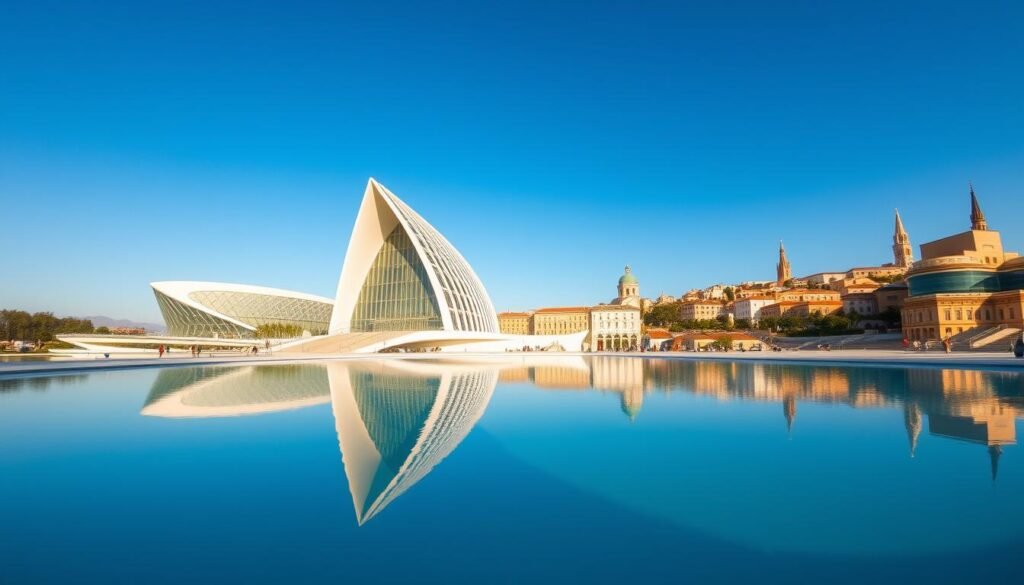
A visit to Valencia pairs hands-on science exhibits with seaside pauses, and I plan my day for both.
I devote a full day to the Ciudad de las Artes y las Ciencias. I start at the Hemisfèric for an IMAX show, then wander the Museu de les Ciències for interactive exhibits.
The Oceanogràfic is Europe’s largest aquarium and makes marine life feel immediate. Nearby, the Palau de les Arts stages an evening performance that changes how the complex feels after dark.
Then I switch gears: La Lonja de la Seda in the old quarter is a UNESCO world heritage site. Its Gothic halls show how trade shaped the city spain and pair well with a saffron-scented lunch where paella was born.
- I pace my days: morning at the city arts sciences, afternoon in the old town, evening on the waterfront.
- The Umbracle offers a golden-hour walk—palms and sculptures against glossy white curves.
- Leave time for Turia gardens and a quick beach stop so a busy time visit still feels like home.
| Site | What I Do | Why it Works |
|---|---|---|
| Hemisfèric | Catch an IMAX or planetarium show | Immersive start that sets a playful tone |
| Oceanogràfic | Plan 2–3 hours for marine habitats | Hands-on displays and close animal encounters |
| La Lonja de la Seda | Short guided walk and local lunch | Gothic architecture and UNESCO heritage site context |
Northern Spain Highlights: Basque Country Flavor and Coastal Views
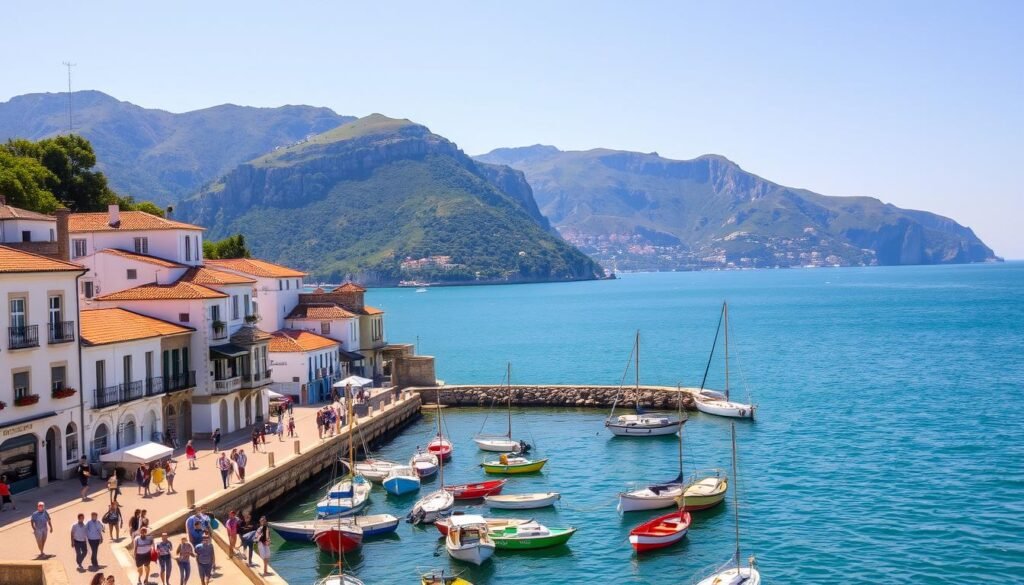
Northern coasts change my pace: crisp sea air, pintxos, and cities that balance modern design with old quarters.You can learn about best-time-to-visit-costa-rica
San Sebastián pairs the golden curve of La Concha with a dining scene that feels like a festival. I split a day between the beach and a pintxos crawl, tasting tiny plates and chatting at crowded counters. Cliffside paths nearby give calm coastal views that reset a busy itinerary.
San Sebastián: golden beaches, pintxos crawls, and cliffside strolls
Food leads my trip here: markets, cider houses, and neighborhood bars make choosing places half the fun. I linger over late dinners and let local chatter shape where I go next.
Bilbao: Guggenheim icon, riverside architecture, and Basque culture
The Guggenheim’s titanium curves anchor Bilbao’s riverfront revival. I plan museum time carefully—it’s closed on Mondays—then pair modern galleries with historic bridges and theaters for a fuller sense of the city’s architecture and world-class art.
- I move between these hubs by train or bus, saving time for waterfront walks and evening plazas.
- Cliff paths deliver dramatic views yet keep restaurants never more than a short stroll away.
- Each return reveals new neighborhoods; Basque Country culture rewards curiosity and lingering.
Andalucía Beyond the Icons: Málaga, Ronda, Cádiz, and Jerez
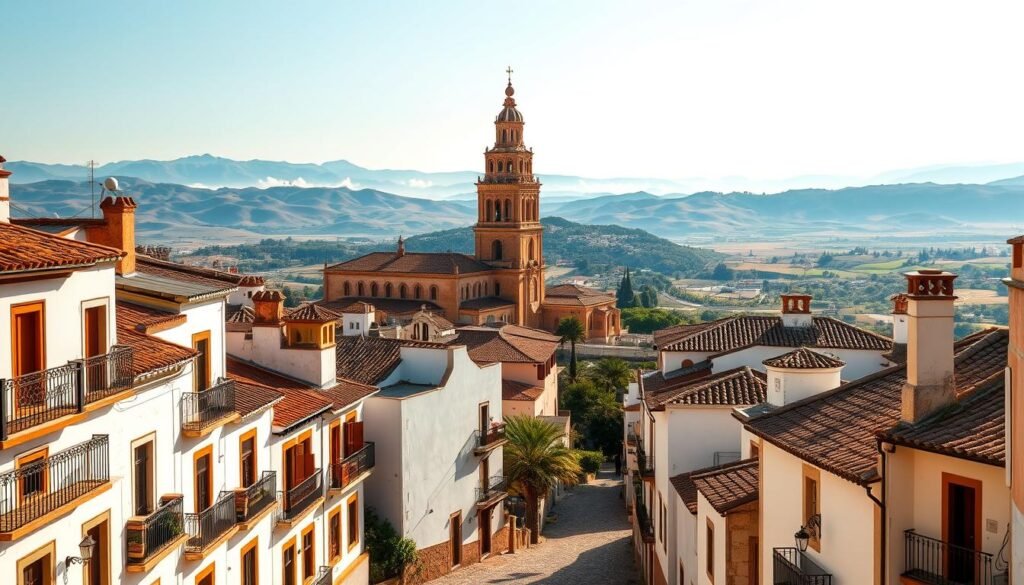
This region mixes centuries of history with lively modern streets and unforgettable views. I tend to build days that pair coast and castle, museums and market stops along the del sol.
Málaga: Alcazaba vistas, cathedral rooftop, and Picasso’s hometown
On the Costa del Sol, Málaga lets me climb the Alcazaba for sweeping city panoramas, then walk to the cathedral rooftop for a different light. The Picasso Museum links local architecture with three centuries of art and family life.
Ronda: Puente Nuevo bridge over a dramatic gorge
Ronda’s Puente Nuevo crosses a 120‑meter gorge. I time my visit for golden-hour views over mountains and white villages that make a short trip feel epic.
Cádiz: Europe’s oldest city, beaches, and Doñana National Park (UNESCO)
Cádiz wears its age with salty charm. At over three thousand years, the port city pairs urban beaches with easy access to Doñana, a nearby unesco world wetland and a true heritage site for wildlife.
Jerez de la Frontera: sherry bodegas and heritage streets
In Jerez I tour bodegas, taste sherry, and let the food and flamenco culture shape an afternoon. The town’s quiet squares reward slow walks, even during busy tourist days.
“These towns prove Andalucía has depth beyond its famous icons.”
Central Spain Day Trips I Swear By: UNESCO Cities and Timeless Streets
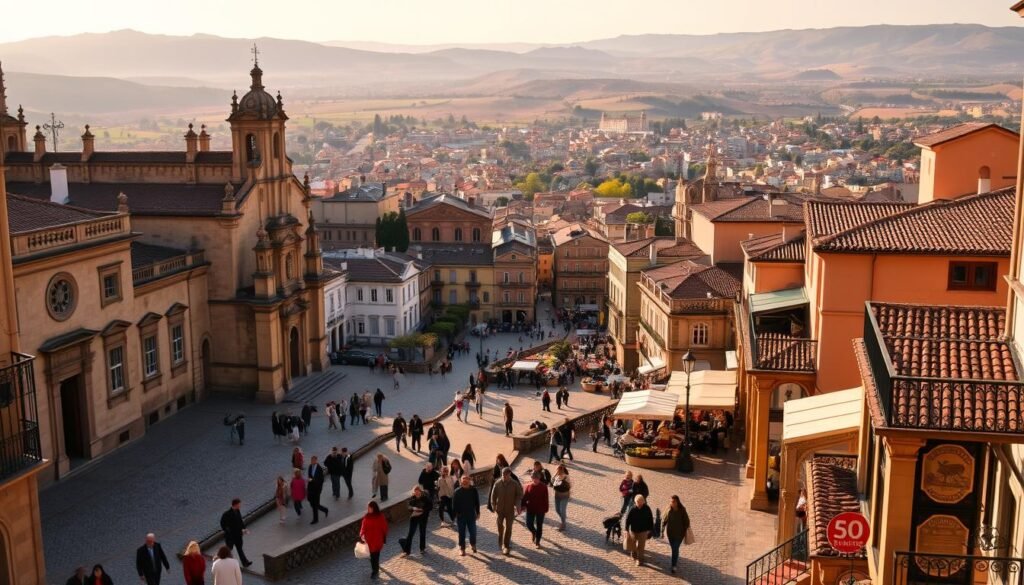
From Madrid I hop on quick trains that turn ambitious plans into relaxed day trips. A 30‑minute ride lands me in Toledo, while Segovia and Ávila sit just over an hour away. That train time makes a full day feel generous.
Toledo: cathedral, Alcázar, and layered Christian-Jewish-Muslim history
Toledo’s cathedral is one of Spain’s finest. The Alcázar now houses a military museum, and narrow streets reveal centuries of shared culture and buildings that tell multi-faith stories.
Segovia: Roman Aqueduct, fairy-tale Alcázar, and Gothic cathedral
Segovia’s 1st-century aqueduct still commands the plaza. The Alcázar looks like a storybook palace and the Gothic cathedral crowns the old town with dramatic views.
Ávila and Salamanca: walls, ramparts, and golden stone
Ávila’s medieval walls invite a walk along the ramparts for skyline views. Salamanca’s UNESCO old town glows at sunset; twin cathedrals and sandstone façades feel carved from light.
- My routine: pick one city per day, start early, and stagger entries to dodge tourist crowds.
“These towns prove how much history a short train ride can unlock.”
Costa Brava and Mediterranean Escapes: Tossa de Mar and Beach Days
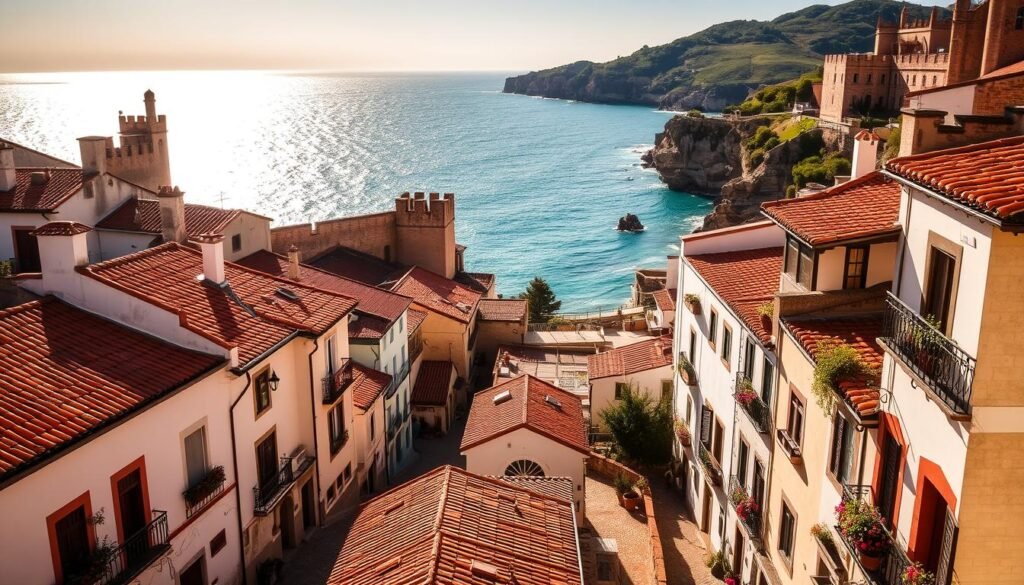
A short drive north of Barcelona, the Costa Brava folds into hidden coves and stone ramparts that invite slow afternoons. I head here when I want a compact mix of history and sea without a long journey.
Tossa de Mar: medieval walls, seven towers, and pine-forest trails
Tossa de Mar wears its past well. The medieval walls and seven towers frame sandy shores and coves that beg for snorkeling.
Pine-forest trails give cooling shade and coastal views, so I balance sunbathing with short hikes that feel fresh and easy.best-time-to-visit-yosemite
My favorite seaside rhythms: snorkeling coves and long tapas lunches
The old town’s cobbled streets are perfect for slow exploration. I linger over seafood and long tapas lunches, then slip into a cove for a quick swim.
It’s one of those quick escape places that resets my pace. Even a single day here gives contrast to city life and adds variety to busy days.
“Medieval towers, translucent water, and a lazy lunch—Tossa does more with less.”
Galicia and the Camino Spirit: Santiago de Compostela and A Coruña
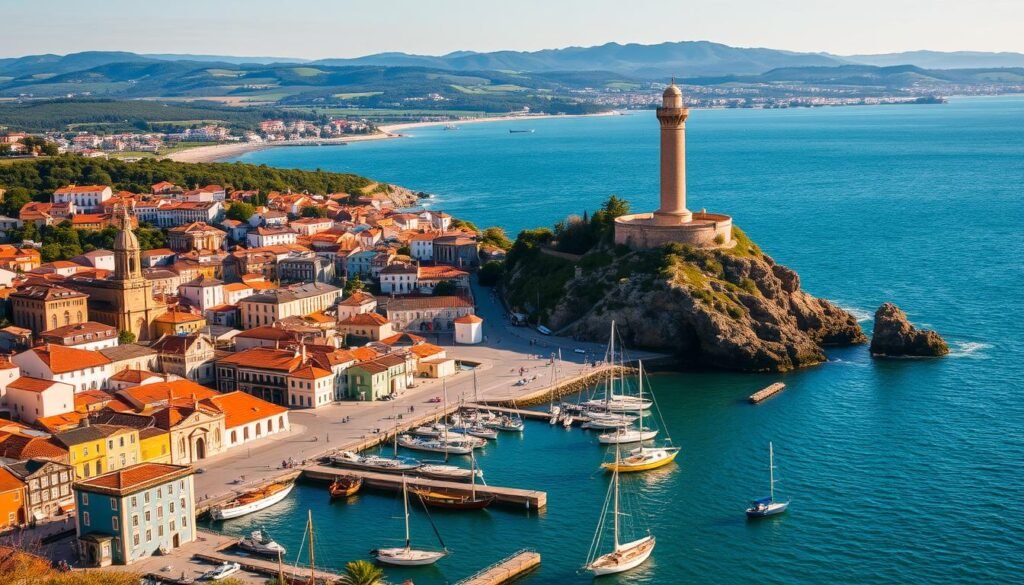
Galicia greets me with a rugged coast and a quiet, pilgrim-shaped rhythm. I feel the Camino’s energy in Santiago’s old town where the cathedral marks a long journey’s end.
Santiago: cathedral finale and UNESCO old town
The cathedral square fills with pilgrims celebrating a moment many plan for years. I spend time on the historic streets, noticing arcades, stonework, and small cafés that hum with stories.
Tip: I time my cathedral visit around services and check opening hours so I can climb rooftop viewpoints and see interior art without rush.
A Coruña: a Roman lighthouse and Atlantic-edge culture
A Coruña sits about an hour north and centers on the Tower of Hercules, the only preserved Roman lighthouse still in use. The climb rewards sweeping Atlantic views that linger long after the ascent.
Galicia’s regional identity shows in markets and marisquerías. I always seek pulpo, shellfish, and a glass of Albariño. Weather can change quickly in northern spain, so I often plan a spare day for museums or covered arcades.
“The mix of coastal walks and spiritual landmarks gives this corner of Spain a mood unlike anywhere else.”
| Site | What I Do | Why it Works |
|---|---|---|
| Santiago Cathedral | Attend service, rooftop visit, stroll old town | Spiritual finale, UNESCO world heritage context, lively streets |
| Old Town Santiago | Arcade cafés and short walks | Stonework details and Camino atmosphere |
| Tower of Hercules (A Coruña) | Climb for coastal views and museum stop | Historic Roman lighthouse with sweeping Atlantic views |
Best Places to Visit in Spain: My Curated List for First-Timers
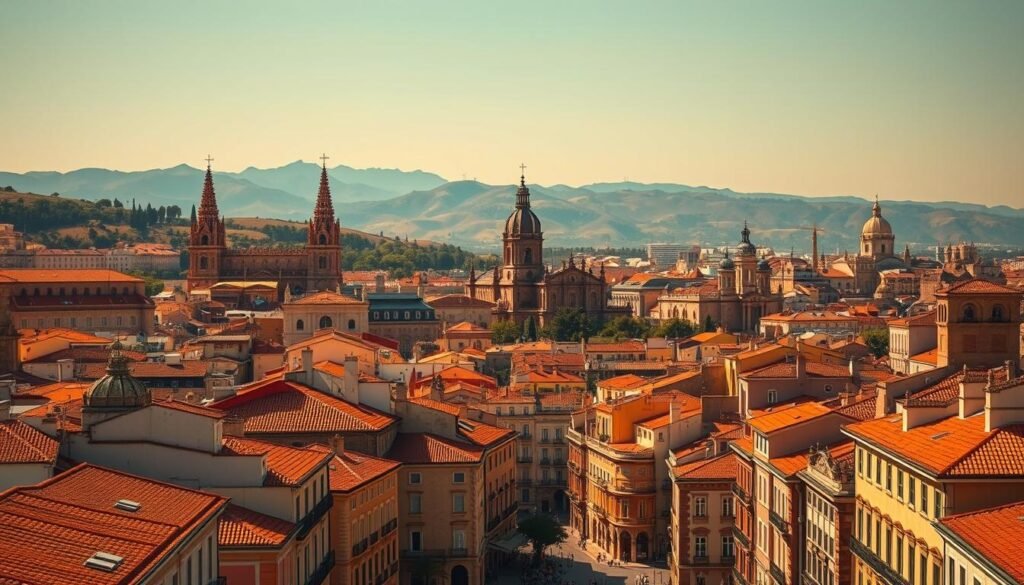
When I plan a first-timer itinerary, I build a simple spine of cities that shows Spain’s big themes without rushing.
I anchor most trips with five core stops: Barcelona, Madrid, Seville, Granada, and Valencia. Each city highlights a different thread—modernist design, museum circuits, Moorish palaces, the Alhambra, and paella culture.
Must-see cities: Barcelona, Madrid, Seville, Granada, Valencia
I spend marquee mornings at Gaudí and museums, then leave afternoons for neighborhood wandering. I prebook key entries so a time visit feels calm rather than rushed.
Where to add days: Basque Country, Central Spain, and Costa del Sol
Add one or two extra days for Basque Country—San Sebastián’s beaches and Bilbao’s Guggenheim are worth it. Or head south to the del sol for Málaga, Ronda, and Cádiz.
Timing your trip: museums, flamenco, festivals, and mild-weather months
I aim for spring or fall when festivals pop and temperatures make long city days pleasant. Use a train for efficient Central Spain day trips—Toledo, Segovia, and Ávila are easy from Madrid and save energy for evening strolls.
- Quick plan: anchor five cities, then layer beaches or UNESCO old towns.
- Museum lovers: prioritize Madrid; design fans choose Barcelona and Valencia.
- Flamenco seekers: make Seville a focal point and leave evenings free for shows.
- Visit planning: prebook hot-ticket entries and keep one meal window open for local discoveries.
“Structure mornings around major sights and save sunsets for plazas or waterfronts.”
Conclusion
I find Spain’s variety folds together into short journeys that feel complete. , I pack mornings with museums or palaces, and leave afternoons for markets, plazas, or a quiet café.
One city can give you art and another a coastline the same day thanks to fast trains. I keep my time visit flexible: book key entries, then wander without a strict plan.
Across region and capital, the world-class museums, UNESCO towns, and lively local culture mean there is plenty to choose from. However you shape your trip, you’ll find a city rhythm that calls you back for more—and new cities spain perspectives each time.


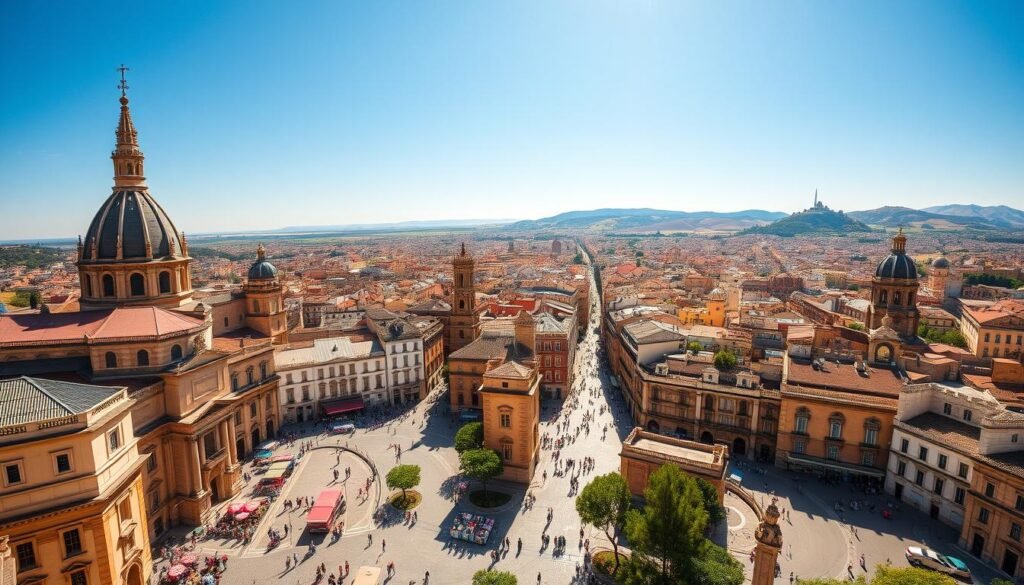



















One Response